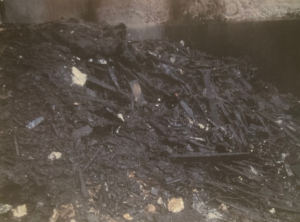A Neighborhood's Long Struggle with an Offensive Landfill, Part III

Sewage-soaked demolition waste at the Lordstown Landfill. Sewage wastes are significantly more expensive to legally dispose in New York so they are often cocktailed into other wastes. The odors caused workers to vomit.
Part III: Smoke and Mirrors
Demolition waste ordinarily contains brick, wood and drywall from razed homes, apartment complexes, commercial and medical facilities, industrial factories as well as agricultural structures. Not often shared with the public is that demolition also includes asbestos from insulation, arsenic from wolmanized patio lumber, lead based paint, mercury from fluorescent lights, mold spores, fiberglass and micro-plastics.
Nearly 50% of the homes in the US contain asbestos. Cleveland has more than 100,000 homes containing asbestos while New York City has 1.3 million.
Since there are minimal regulations on emptying buildings before leveling them, demolition waste often contains pesticides stored in barns, chemicals left in factories and waste oil from garages. Household hazardous wastes including bleaches, detergents, drain cleaners, medical waste and pharmaceuticals have been found in Lordstown's waste. Any of these contaminants could be found in the water or dust coming from the landfill.
Lafarge’s customers often pulverize their waste to maximize railcar volume and may cocktail pernicious materials into the unidentifiable demolition.
Lafarge excavated a massive 30 acre hole and exposed two groundwater tables allowing 40 million gallons of water a year to pour into the landfill, ad infinitum. In violation of Ohio EPA’s regulations, a pumping system was installed to keep the hole from collapsing until it could be filled with millions of tons of waste.
Drywall and other wastes quickly decomposed in the huge muck-hole creating toxic hydrogen sulfide gas. The gas smells like putrid rotten eggs, causes many medical problems and is lethal at high concentrations. The many other poisonous gases at Lafarge were not discovered until 2019.
The Neighbors Push Back
The neighbors were overwhelmed with stink and nausea. More than 200 complaints were filed and the first anti-landfill citizens group was created. Regarding the stench, Ellen Dingus, a Lafarge neighbor, put it succinctly to WKBN27 TV: ‘It makes you want to puke”.
Complaints were filed with the Health Department, the Ohio EPA, the Youngstown Air Agency and just about any government agency that would answer the phone — but conditions never improved. The neighbors coughed, wretched and seethed.
Lafarge’s landfill annual license hearing is always held in mid-December by the Trumbull County Board of Health. Hearings were originally held at 6:00 pm while the venue rotated through various township halls. This arrangement gave the community an opportunity to share their concerns about odors, dust, litter and muddy roads.
Rumors circulated that the 2011 hearing was going to be riotous, so security was provided. Indeed, dozens of angry residents arrived and were shouting from the start of the session. When the landfill’s license was approved for another year (of course), the intensity grew into face to face situations. There was no physical altercations but it was close.
The Board of Health now holds the license hearings at 1:00 in the afternoon in the smallest of conference rooms. By the time the Board Members, the program supervisors, the county solicitor, the finance director and the stenographer are seated there are enough chairs and oxygen for eight visitors — if they can get off work.
By 2012, Lafarge had disposed of a whopping 56,000 railcars and now up to 100 truckloads of waste a day were rolling in.
The largest internal problem the landfill faced was the giant CAT 775 mine trucks. Lafarge’s customers needed their empty railcars back and the round trip on CSX takes two weeks. Production was maximized and the stout trucks were overloaded. Between the 50 ton payloads and the steep, muddy haul roads, axles snapped, frames collapsed, hydraulic bed cylinders failed and the loaded 175,000 pound trucks rolled over — and still do. But most problems are overlooked by big profits.
However, ongoing complaints and the plethora of Ohio EPA violations placed landfill’s annual license at risk. The neighbors were taking action and so the company did the same.
The neighbors’ homes are so close to the landfill that they could not avoid seeing the daily operation. They had also become somewhat familiar with the waste regulations. The huge trucks then dumped so neighbors could not see the pulverized waste or the dust plumes.
Archived Ohio Secretary of State campaign contribution records show that during this time, Lafarge and/or the Lordstown Landfill spread tens of thousands of dollars to no less than 32 different local and state candidates — but it is unclear if any unreported contributions were made. Additionally, landfill personnel were asked to contribute and be reimbursed in their paychecks.
These actions, combined with the millions in disposal fees allocated to the Village of Lordstown, the Trumbull County Health Department and the State of Ohio, somewhat neutralized the residents’ genuine complaints about the awful stink, the dust and the sickness.
In the spring of 2012, a distraught landfill manager sent senior management a scathing, fact-filled internal report on the groundwater pumping, the cocktailed pulverized waste and the legitimacy of the odor complaints at the landfill. He was naive enough to tell the king he had no clothes on and was quickly banished.
These issues would come back to haunt Lafarge in a massive 45-page Ohio EPA consent order.
Next: Part IV “Living the Lie"
Markus Aurelius
citizensagainstlordstownlandfill.org
toxictruth@citizensagainstlordstownlandfill.org
Legal Disclaimer:
EIN Presswire provides this news content "as is" without warranty of any kind. We do not accept any responsibility or liability for the accuracy, content, images, videos, licenses, completeness, legality, or reliability of the information contained in this article. If you have any complaints or copyright issues related to this article, kindly contact the author above.


